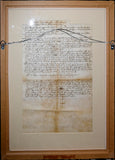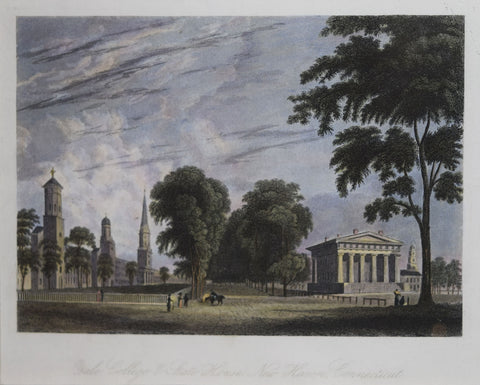Franz Daniel Pastorius (1651-ca. 1720), The Original Plan Of Germantown, The Cradle Of German-American Immigration.
Franz Daniel Pastorius (1651-ca. 1720)
The Original Plan Of Germantown, The Cradle Of
German-American Immigration.
Germantown: ca. 1686-1687.
Sheet: 15 11/16 x 9 15/16 in.
Map and annotations recto, description of the settlement verso; all in ink. Three folds resulting in eight compartments. Splits and losses at the folds, some repaired. Scattered browning, bleed-through and ink-burn. Pricked for copying. Matted and framed, glassed verso.
Franz Daniel Pastorius (1651-ca. 1720) was born in Sommerhausen in the duchy of Franconia, within modern Bavaria in Germany. He received his doctorate in law in 1675 and practiced and taught for a few years before going abroad in 1680, including to England. Upon his return in 1682 he heard of the early Christian settlements in William Penn’s Pennsylvania, a promised land of tolerance and abundance. By the 16th of August 1683 he had landed in the New World and befriended Penn himself (at the right-hand side of the map is the annotation in Pastorius’s hand: “den Springfield, welches/ Willjam Penns mannor ist” (to Springfield, which is William Penn’s manor)). From Penn Pastorius bought land north-northwest of Philadelphia and established Germantown as a dedicated settlement for immigrants from along the Rhine: German, Dutch and Swiss. Here Penn’s utopia of religious pluralism came to nourish a multitude of denominations (Lutheran, Mennonite, Quaker, Pietist, Brethren (Dunkers or Dunkards) etc.) and eventually gave birth to the first American condemnation of human bondage: the 1688 Germantown Quaker petition against slavery.
The present item is the original map, carried out in Pastorius’s own hand, for that foundational settlement (there is text in a second hand as well; it is unclear whose, but it is likely a clerk’s). As such, it is among the earliest surviving American town plans (cf. the 1683 Holmes map of Philadelphia), and an unparalleled source of information. The map is oriented with Southwest at the top. Its principle features are the river system in the area, the measured boundaries of the settlement and some internal markings of roads and lots. This last is the subject of the text at the upper right-hand corner of the map: lot-holders’ names arranged in spatial order (in the second hand). Given the known dates of lot-holders’ arrivals, Duffin dates the map proper to December 1686 or January 1687. The marginalia are later than the map itself: those at the lower edge record some of the history of the settlement as far as Pastorius’s election to the mayoralty in or after July 1688, and the lot-holders dates to between August 1688 and March 1689. The verso of the sheet contains a 35-line description headed “Situation der Germantownship in Pennsilvania/ 6 Englishe Meil von Philadelphia gelegen” (the situation of Germantown in Pennsylvania, 6 English miles distant from Philadelphia) written in Pastorius’s hand. The text can be dated to late 1687; Pastorius gives the town 5,190 acres, but it was re-surveyed from 29 December 1687 into January of 1688 and found to contain 5,700 acres. In it, Pastorius describes the township’s placement in relation to other natural and built land-marks, and finally the lot-holders, with indications of their origins, hereditary rights and extents.
The map was owned by Samuel Whitaker Pennypacker (1843-1916), Governor of Pennsylvania and an avid historian and collector of Pennsylvaniana. It was reproduced as illustration 104 in his 1899 Settlement of Germantown (Philadelphia: Campbell) with the notation “From the original in the library of the Author.” The Pennypacker sale (eight parts from 1905 to 1909) disbursed a good deal of his collection, but the present item does not appear in that catalogue. A note affixed to the verso of the frame claims that “it is thought to have been Penn’s own copy,” which is difficult to assess. Duffin, James M. “The First Map of Germantown: A Neglected Source.” The Germantown Crier (44.2) Fall, 1992, pp. 4-17.
We Also Recommend







![American School, [Manuscript Map of Pennsylvania]](http://aradergalleries.com/cdn/shop/products/Manuscript_Map_of_Pennsylvania_large.jpg?v=1470162735)
